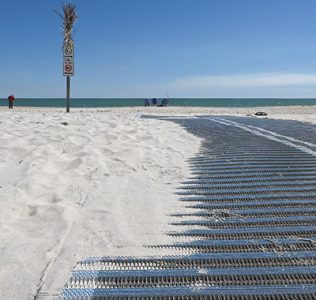Beaches
Beach access will roll with the storms

A $5,500 plastic fiber mat will replace a $30,000 wooden walkway at the First Street beach access on Pawleys Island. It will be the first public use of the mats in Georgetown County outside of Huntington Beach State Park.
“There is some permitting we’ve got to go through with the state, but I’ve got what I need to proceed with that as soon as we’re ready,” Administrator Dan Newquist told Town Council this week.
He started researching a product called Mobi-mat earlier this year. The mat would be placed on top of the sand.
The wooden walkway, which provides access for emergency vehicles, was damaged by Hurricane Ian in September. The debris was removed to allow heavy equipment to get onto the beach to repair erosion damage to the sand dunes.
The town is eligible to get reimbursement from the Federal Emergency Management Agency for 75 percent of the cost of a new ramp.
“If we’re going to do a Mobi-mat system, I don’t know if we would get reimbursed,” Newquist said. “It’s not what was there before.”
A 5-foot-wide, 50-foot-long Mobi-mat would cost a little over $3,000, including shipping.
Council Member Sarah Zimmerman asked about a wider mat to better accommodate emergency vehicles.
A 10-foot wide mat the same length would cost $5,500, Newquist said.
Police Chief Mike Fanning told council that Midway Fire and Rescue has asked for access on the north end for emergency vehicles.
“I’ve seen it at Huntington Beach and down at Hilton Head,” Fanning said of the Mobi-mat. “It works well.”
Council Member Guerry Green pointed out that even if FEMA doesn’t cover the cost of the mat, the cost to the town is still less than rebuilding a wooden ramp with federal aid.
“You can get it done quick and pick it up and move it when there’s a storm,” he said.
The council agreed to buy the wider mat. Newquist said it could be shipped by the end of the month.
The state Department of Health and Environmental Control permits the use of the mats, according to an agency spokeswoman.
A mat that extends seaward of the primary dune requires a major permit, and is likely to come with conditions, she said.
The town is still working to get reimbursement from FEMA for the cost of preparing for Hurricane Ian and cleaning up afterward.
The biggest expense was $144,050 for dune planting. The town hopes to get 75 percent of that from FEMA.
The process is tedious, Newquist said. The reimbursement to replace signs warning people to stay off the dune includes GPS locations for all the signs.
“I’ve got a lot of inquiries from property owners. They’re observing people coming onto the dune,” he said.
Newquist is confident the town will get the funding.
“I’m just waiting for that final authorization,” he said.





